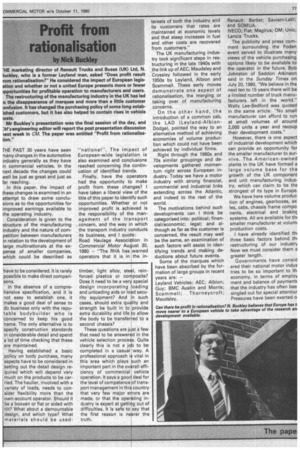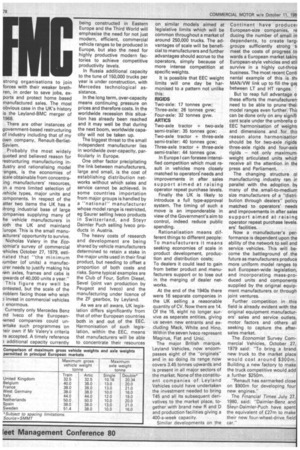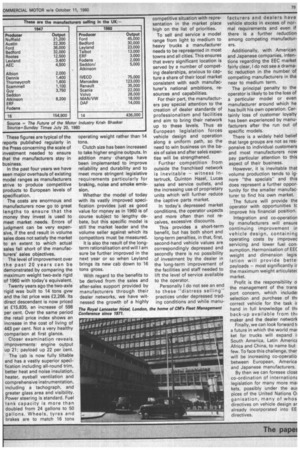Profit from rationalisation
Page 79

Page 80

Page 81

If you've noticed an error in this article please click here to report it so we can fix it.
by Nick Buckley
THE PAST 30 years have seen many changes in the automotive Industry generally as they have in commercial vehicles. In the next decade the changes could well be just as great and just as far reaching.
In this paper, the impact of these changes is examined in an attempt to draw some conclusions as to the opportunities for improved earnings available to the operating industry.
Consideration is given to the structure of the manufacturing industry and the nature of competition between manufacturers in relation to the development of large multinationals at the expense of smaller companies, which could be described as "national". The impact of European-wide legislation is also examined and conclusions reached concerning the continuation of identified trends.
Finally, have the operators had the opportunity to make profit from these changes? I have taken a liberal view of the title of this paper to identify such opportunities. Whether or not improved profit is achieved is the responsibility of the management of the transport concern, and the way in which ,the transport industry conducts its business, and I quote: Road Haulage Association in Commercial Motor August 30, 1980 — "The RHA has warned operators that it is in the in terests of both the industry and its customers that rates are maintained at economic levels and that steep increases in fuel and other costs are recovered from customers."
The UK manufacturing industry took significant steps in restructuring in the late 1940s with ,the link up of AEC, Maudsley and Crossley followed in the early 1950s by Leyland, Albion and Scammell. These early moves demonstrate one aspect of rationalisation, the merging or taking over of manufacturing concerns.
On the other hand, the introduction of a common cab, the LAD (Leyland-AlbionDodge), pointed the way to an alternative method of achieving economies of volume production which could not have been achieved by individual firms. Right through the 1960s and 70s similar groupings and developments gathered momentum right across European industry. Today we have a motor industry with strong financial, commercial and industrial links extending across the Atlantic, and indeed to the rest of the world.
The motivations behind such developments can I think be categorised into: political; financial/economic; legal; and al though as far as the customer is concerned, the result may well be the same, an examination of such factors will assist in identifying trends and making deductions about future events.
Some of the marques which have been absorbed by the formation of large groups in recent years are: — Leyland Vehicles: AEC; Albion; Guy; BMC Austin and Morris; Scammell; Thorneycroft; Maudsley. Renault: Berliet; Saviem-Latil; and SOMUA.
IVECO; Fiat; Magirus; OM; Unic; Lancia Trucks.
The publicity and press comment surrounding the Foden event served to illustrate many views of the vehicle purchasing options likely to be available to the operator in the future. Bob Johnston of Seddon Atkinson said in the Sunday Times on July 20, 1980, "We believe in the next ten to 15 years there will be a limited number of truck manufacturers left in the world." Wally Lee-Bedford was quoted in the same article: "No small manufacturer can afford to run at small volumes of around 2,000 units a year and recoup their development costs."
However, there is one aspect of industrial development which can provide an opportunity for the smaller manufacturer to survive. The American-owned plants in the UK have formed a large volume base for the growth of the UK component and unit manufacturing industry, which can claim to be the strongest of its type in Europe.
We have here volume produc. tion of engines, gearboxes, ax. les, cabs, chassis frame compa nents, electrical and brakinc, systems. All are available for thi smaller manufacturer at volurni production costs.
I have already identified thi three basic factors behind thi restructuring of our industry Now we must consider them a greater length.
Governments have consid ered their national motor indus tries to be so important to th, economy, in terms of employ ment and balance of payment; that the industry has often bee singled out for special attentior Pressures have been exerted o
strong organisations to join forces with their weaker brethren, in order to save jobs, exports and protect home based manufactured sales. The most obvious case in the UK's history is the Leyland-BMC merger of 1968.
There are other instances of government-based restructuring of industry including that of my own company, Renault-BerlietSaviern,
Probably the most widely quoted and believed reason for restructuring manufacturing inJustry and rationalising model -anges, is the economies of scale obtainable from concentra.ing manufacturers' resources, )n a more limited selection of /ehicle types, major units and :omponents. In respect of the atter two items the UK has a ;trong industrial base of large ;ompanies supplying many of he vehicle manufacturers in )oth the UK and mainland urope. This is the small manuacturers' opportunity to survive. Nicholas Valery in the Eco)omist's survey of commercial :ehicles October 27, 1979, estinated that "the minimum lumber (of units) a rnanufacurer needs to justify making his Iwn axles, frames and cabs is pwards of 40,000 units a year." This figure may well be ontested, but the scale of the roblem facing those who wish ) invest in commercial vehicles ; enormous.
Currently only Mercedes Benz nd Iveco of the EuropeanIwned companies could unertake such programmes on -left own if Mr Valery's criteria re accepted. A timely reference ) additional capacity currently
being constructed in Eastern Europe and the Third World will emphasise the need for not just modern, efficient, commercial vehicle ranges to be produced in Europe, but also the need for highly productive modern factories to achieve competitive productivity levels.
In Russia additional capacity to the tune of 150,000 trucks per year is under construction, with Mercedes technological assistance.
In the long term, over-capacity means continuing pressure on prices and therefore costs. In the worldwide recession this situation has already been reached and it may well be that during the next boom, worldwide capacity will not be taken up.
The biggest threat to the small independent manufacturer lies in worldwide over-capacity, particularly in Europe.
One other factor precipitating the link between manufacturers, large and small, is the cost of establishing distribution networks without which sales and service cannot be achieved. In some countries importation from major groups is handled by a "national" manufacturer whose model range is restricted, eg Saurer selling Iveco products in Switzerland, and Steyr Daimler Puch selling Iveco products in Austria.
The heavy costs of research and development are being shared by vehicle manufacturers determined to retain a stake in the major units used in their final product, but needing to offset a proportion of both costs and risks. Some typical examples are the Club of Four, Sofim Diesel, Sevel (joint van production by Peugeot and Iveco) and the manufacturing under licence of the ZF gearbox, by Leyland.
As we are all aware, UK legislation differs significantly from that of other European countries both in and out of the EEC. Harmonisation of such legislation, within the EEC, means that manufacturers will be able to concentrate their resources on similar models aimed at legislative limits which will be common throughout a market of around 250,000 trucks. The advantages of scale will be beneficial to manufacturers and further advantages should accrue to the operators, simply because of more intense competition at specific weights.
It is possible that EEC weight limits will one day be harmonised to a pattern not unlike this: RIGIDS Two-axle: 17 tonnes gvw; Three-axle: 26 tonnes gvw; Four-axle: 32 tonnes gvw.
ARTICS Two-axle tractor + two-axle semi-trailer: 35 tonnes gcw; Two-axle tractor + three-axle semi-trailer: 40 tonnes gcw; Three-axle tractor + three-axle semi-trailer: 44 tonnes gcw.
In Europe I can foresee intensified competition which must result in vehicles more closely matched to operators' needs and improvements in after sales support aimed at raising operator repeat purchase levels.
Finally the UK is likely to introduce a full type-approval system. The timing of such a move is an imponderable in view of the Government's aim to control, indeed reduce public spending.
Rationalisation means different things to different people: To manufacturers it means seeking economies of scale in product development, production and distribution costs; To dealers it could lead to gain from better product and manufacturers support or to lose out in the merging of dealer networks.
At the end of the 1940s there were 16 separate companies in the UK selling a reasonable quantity of CV. Now there are 14. Of the 16, eight no longer survive as separate entities, giving us seven new entrants and excluding Mack, White and Hino. Within the seven Iveco represent Magirus, Fiat and Unic.
The major British marque, Leyland Vehicles, now encompasses eight of the "originals" and in so doing its range now covers 3.45 tonnes upwards and is present in all major sectors of the market. None of the constituent companies of Leyland Vehicles could have undertaken the investment needed to bring T45 and all its subsequent derivatives to the market place, together with brand new R and D and production facilities giving a 400-a-week capacity.
Similar developments on the Continent have produce( European-size companies, re clueing the number of small in dependents, to create largi groups sufficiently strong tc meet the costs of progress to wards a European market takinc European-style vehicles and stil survive in a highly cut-throa business. The most recent Conti nental example of this is thi MAN/VW link up to fill the ga between LT and HT ranges.
But to reap full advantage o these efforts the manufacturer!
need to be able to prune thei model ranges even further. Thi: can be done only on any signifi cant scale under the umbrella a EEC harmonisation of weight: and dimensions and for thit reason alone harmonisatior should be for two-axle rigids three-axle rigids and four-axIE rigids not only maximum. weight articulated units which receive all the attention in thE press and Parliament.
The changing structure ol manufacturing industry ran ir parallel with the adoption by many of the small-to-medium size manufacturers of a "distribution through dealers" policy matched to operators' needs and improvements in after sales support aimed at raising operator repeat purchase levels. ers' facilities.
Now a manufacturer's performance is dependent upon the ability of the network to sell and service vehicles. This will become the battleground of the future as manufacturers produce more uniform model ranges to suit European-wide legislation, and incorporating mass-produced units and components supplied by the original equipment manufacturers or through joint ventures.
Further competition in this field is already evident with the original equipment manufacturers' sales and service outlets, motor factors and others all seeking to capture the aftersales market.
The Economist Survey Commercial Vehicles, October 27, 1979 said: "To bring a brand new truck to the market place would cost around $300m. Building a new factory to make the truck competitive would add a further $250m.
"Renault has earmarked close on $900m for developing four new engines."
The Financial Times July 27, 1980, said: "Daimler-Benz and Steyr-Daimler-Puch have spent the equivalent of E27m to make their new four-wheel-drive field car."
These figures are typical of the reports published regularly in the Press concerning the scale of investment needed to ensure that the manufacturers stay in business.
In the past four years we have seen major overhauls of existing model ranges as manufacturers strive to produce competitive products to European levels of specification.
The costs are enormous and manufacturers now go to great lengths to ensure that the money they invest is used to meet market needs. Errors of judgment can be very expensive, if the end result in volume sales does not satisfy the market to an extent to which actual sales fall short of the manufacturers' sales objectives.
The level of improvement over the past 20 years can be demonstrated by comparing the maximum weight two-axle rigid of 1960 with today's equivalent„ Twenty years ago the two-axle rigid was built to 14 tons gvw and the list price was £2,266. Its direct descendant is now priced at £15,835, an increase of 598 per cent. Over the same period the retail price index shows an increase in the cost of living of 443 per cent. Not a very healthy comparison at first glance.
Closer examination reveals improvements: engine output up 21; payload up 22 per cent.
The cab is now fully tiltable and has a vastly superior specification including all-round trim, better heat and noise insulation, heater, eyeball ventilation and comprehensive instrumentation, including a tachograph, and greater glass area and visibility. Power steering is standard. Fuel tank capacity is more than doubled from 24 gallons to 50 gallons. Wheels, tyres and brakes are to match 16 tons operating weight rather than 14 tons.
Clutch size has been increased to take higher engine outputs. In addition many changes have been implemented to improve reliability and durability and to meet more stringent legislative requirements particularly for braking, noise and smoke emission.
Whether the model of today with its vastly improved specification provides just as good value for money as in 1960 is of course subject to lengthy debate, but this specific model is still the market leader and the volume seller against which its competitors must be measured.
It is also the result of the longterm rationalisation and will I am sure be further improved in the next year or so when Leyland brings its new cab down to 16 tons gross.
With regard to the benefits to be derived from the sales and after-sales support provided by manufacturers through their dealer networks, we have witnessed the growth of a highly competitive situation with representation in the market place high on the list of priorities.
To sell and service a model range from light to medium to heavy trucks a manufacturer needs to be repreeented in most towns and all cities. This ensures that every significant location is served by a number of competing dealerships, anxious to capture a share of their local market consistent with each manufacturer's national ambitions, resources and capabilities.
For their part, the manufacturers pay special attention to the creation of dealer standards of professionalism and facilities and aim to bring their network up to these levels. Thus as European legislation forces vehicle design and operation along a uniform path, so the need to win business on the basis of sales and after sales expertise will be strengthened.
Further competition from outside the franchised network is inevitable witness Intertruck, Quinton Hazel, Lucas sales and service outlets, and the increasing use of proprietary units which will further reduce the Captive parts market.
In today's depressed market conditions, the operator expects and more often than not receives, excessive discounts.
This provides a short-term benefit, but has both short and long-term penalties, in that, first, second-hand vehicle values are correspondingly depressed and secondly there is no possibility of investment by the dealer in the long-term improvement of the facilities and staff needed to lift the level of service available to the operator.
Personally I do not see an end to these "distress selling" practices under depressed trading conditions and while manu
facturers and dealers have vehicle stocks in excess of normal requirements and even if there is a further reduction among competing manufacturerS.
Additionally, with American and Japanese companies, intentions regarding the EEC market fairly clear, I do not see a dramatic reduction in the number of competing manufacturers in the near to medium term.
The principal penalty to the operator is likely to be the loss of a particular model or even manufacturer around which he has built his own operation. Certainly loss of customer loyalty has been experienced by manufacturers after the run out of specific models.
There is a widely held belief that large groups are not as responsive to individual customers and most manufacturers now pay particular attention to this aspect of their business.
However, it is inevitable that volume production tends to ignore "the specials" and this does represent a further opportunity for the smaller manufacturer to find his own market.
The future will provide the operator with opportunities tc improve his financial position.
Integration and co-operation by manufacturers will ensure continuing improvement in vehicle design, containing operating costs by improved servicing and lower fuel consumption. Harmonisation of EEC weight and dimension legis lation will provide bettel payloads -most significantly ir the maximum weight articulate( market.
Profit is the responsibility o the management of the trans port concern, which include: selection and purchase of thE correct vehicle for the task ir hand in full knowledge of thE back-up available from thE maker and the dealer network Finally, we can look forward ti a future in which the world mar ket for trucks will expand ii South America, Latin America Africa and China, to name but few. To face this challenge, ther will be increasing co-operatio between European, America and Japanese manufacturers.
By then we can foresee close co-ordination of internationa
legislation for many more mai
kets, possibly under the aut pices of the United Nations Oi ganisation, many of whos directives on vehicle design ar already incorporated into EE directives.












































































































































































